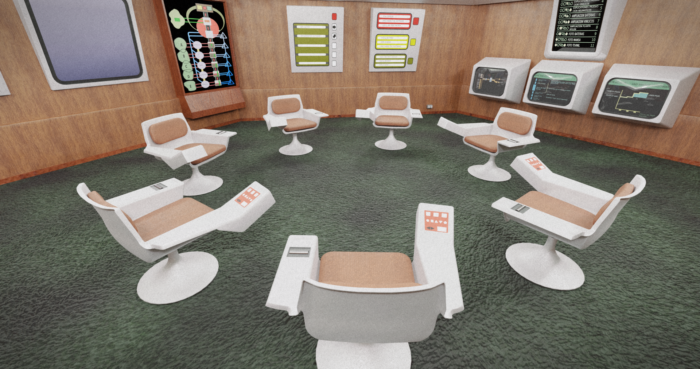
In turn, we use cookies to measure and obtain statistical data about the navigation of the users. You can configure and accept the use of the cookies, and modify your consent options, at any time.

Brian David Johnson is a Professor of Practice at Arizona State University, a Futurist and Fellow at the business consulting firm Frost & Sullivan, and a former engineer and Chief Futurist at the Intel Corporation. He is the originator of ‘sci-fi prototyping’, a technique that uses short original pieces of science fiction to model possible futures. We met with Johnson to learn more about how he uses comic books and short stories set in fictional futures to help organisations discover previously unseen threats.
What exactly is science fiction prototyping?
In short, it’s a way to use science fiction as a futures modelling tool. It’s not science fiction, but rather science fiction thinking. This distinction is important because the intent of science fiction is most often to entertain you, or if we’re being quite honest, to sell movie tickets or books. And that’s not a bad thing. But the intention of science fiction prototyping is very different in that it is a tool to be used to discover potential futures and threats that people hadn’t thought about.
How is this done?
One of the methodologies I use in my work as an applied futurist is called ‘threatcasting’, which, as the name implies, is about looking at a range of potential future threats, modelling how they would play out, and assessing which steps would be necessary to take today to avoid them. Science fiction prototyping is a tool we can use to take this process a step beyond the abstract, to have characters and situations that bring the futures to life. This pushes people to use their imagination more freely, sometimes to get them right up to the edge of the possible.
When I was employed as Chief Futurist at the Intel Corporation, I used sci-fi prototyping to threatcast some very dark futures based on the technologies that Intel was building. I would then share these visions with my fellow engineers which often freaked them out because they could see the awful things that could happen. I once had a colleague get up and walk out of a meeting because he was so upset by the possibility that somebody could take a piece of technology – a piece of engineering that he loves so dearly – and use it to cause harm.
Sci-fi prototypes can be used both in this way, to get people thinking differently about the future and to provoke conversations – sometimes uncomfortable ones – but also to create a common language to talk about the future in a way that is imaginative but also science and fact based.
What does a sci-fi prototype modelling a future threat look like? Can you give us an example?
It can look like a comic book or a graphic novel.
A lot of the work we do at our Threatcasting Lab at Arizona State University has to do with national security, global security, and climate resource security. We recently did a piece for the United States Army Cyber Institute that examined the future of quantum technologies and their potential use in warfare. Quantum computing is deep, nerdy math stuff and something that’s hard for a lot of people to wrap their heads around. With sci-fi prototyping you can take these more technical aspects and apply them to real-life situations, getting into what the effects of the technology would be for people on the ground in a visceral and easily understandable way.
The result of our prototyping process was a piece called Quantum Winner. In it, you follow three soldiers on the ground caught in the middle of a battle where quantum technology is being used. We see the breaking of encryption, the breakdown of GPS, and other technological failures, as well as the effects this would have on the soldiers. The piece never uses the word ‘quantum’ except for in its title because the goal is not to explain the technology but to shows you the effects. It’s dark stuff, and it’s meant to provoke a reaction you wouldn’t get from a high-level research paper or scenario planning exercise.
Why are military institutions and other organisations hiring comic book writers and sci-fi authors to tell them of these threats?
I think as we moved from the 20th century to the 21st century, there’s a was a massive shift in the way people thought about technology and the future. There is a legacy around futurists as charlatans and snake oil salesmen that isn’t so great. Luckily, we’ve left a lot of that behind. And once people accepted futures thinking as a necessity, they started feeling a lot more comfortable moving on to science fiction and sci-fi prototyping.
Then there’s the fact that engineers and technologists have always found blueprints for innovation in sci-fi – flip phones, rockets, the metaverse, you name it. Although you can teach someone to be a sci-fi author, you can’t teach someone to be Neil Stevenson, Gene Roddenberry, or Isaac Asimov. Sci-fi prototyping is something you can teach. It’s not as reliant on that single brilliant person and their ideas. And because the process is repeatable, organisations can depend upon it year over year in their long-term strategic planning.
What makes science fiction prototyping different from other futurist methods like scenario planning, which also involve elements of storytelling?
Scenario planning is a very powerful tool in futures work. But I often argue that while it was a great fit for the 20th century, and a necessity for the 21st, it is no longer sufficient.
For one, scenarios and other similar methodologies are not great at capturing the almost quantum-like complexity of many issues facing us today. It’s also bloodless. Human beings are messy, quirky, wonderful, and cruel. Generally, scenario planning doesn’t capture that well because it’s not its goal. With sci-fi prototyping you can get into the weirdness by focusing on situations, technologies, and characters who think, feel and act. It exposes you to a level of detail that’s unrivalled in other futurist methodologies. Say, for instance, you are modelling a large-scale cyber-attack. With sci-fi prototyping you can get into what that would look like if you were sitting in an autonomous car or looking at your phone while it was happening – in other words, how it affects people on the ground.
Science fiction is often subversive, critical of the status quo and the powers that be – warning us of abuses of power or what happens when technology runs amok or is used to cause harm. Yet sci-fi prototyping is often used to do innovation sandboxing for the kinds of institutions that sometimes take the role of the villain in in works of sci-fi literature. Do you see a conflict there?
It’s true that really good works of science fiction are often cautionary tales that show us a bad future and warns us to not let that happen. The perfect example of that is George Orwell’s 1984. There are many authors working today who carry on that legacy, including Cory Doctorow, who is very clear he’s not a futurist but an activist and a writer intent on showing people the risks and dark sides of the digital future.
In my experience, sci-fi prototyping can function in a similar way in that it can be used to counter prevailing narratives and explore all the things that could go wrong. It challenges people to think through extreme and often uncomfortable scenarios. A recent example of this is a prototype we did for Cisco, looking at the intersection between global supply chains, cyber-attacks, and terrorism, which resulted in a graphic novella called Two days after Tuesday. The story breaks down how a small ‘spear phishing’ attack at the edge of a supply chain could cause a major disaster. We show the step-by-step process through which hackers and state-sponsored terrorists could create a physical vulnerability at a port to sneak in a dirty bomb and detonate it on the island of Manhattan during rush hour. The point of going to this awful and dark place is not to have a story about villains or heroes, but to show how wrong this can quickly go, and – from a network security perspective – provoke a conversation around what could be done to prevent such a scenario from occurring.
This last part is crucial because once we’ve seen how bad things can go, we then need to ask: OK, so what do we do about it? Ultimately, the goal of envisioning futures through sci-fi prototyping is to empower action. That’s why we go to those dark places. Ultimately, the intent is to make the world better and safer.